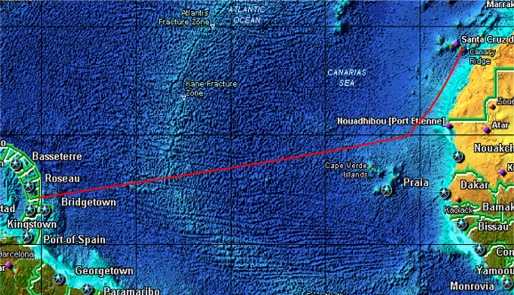Sister's Itinerary
November 21, 1999 - December 13, 1999 |
Crossing the Atlantic |
|
|
We went south at first because there was supposed to be more wind there |
| To help minimize the risk of crossing the Atlantic and to participate in a fun event we signed up for the Atlantic Rally for Cruisers. |
|
Every November since 1986 the ARC has left Las Palmas de la Gran Canaria for the Caribbean. For the first four years the Caribbean destination was on the island of Barbados, but since 1990 the destination has been Rodney Bay, on the island of St. Lucia. When we crossed some 240 boats participated. |
|
The ARC is officially a race, promoting "friendly competition" among a large variety of ocean going boats (including power boats). There are a variety of divisions some of which are more race oriented than others. Boats in the most competitive division must have a valid "Channel Handicap System" certificate so they can be properly handicapped against other boats in their division. |
|
Sister was in a division which is handicapped by the World Cruising Association, the organizers of the ARC. This division is much more "laid back" than the primo racing division. Boats in this division may use their engines as they see fit as long as engine use is logged and reported to the race committee via high frequency radio daily. |
The primary benefit in joining the ARC is the opportunity to cross the Atlantic in the company of a large group of boats. Although after even just one day at sea it is rare to even see another ARC participant, one is almost always in close enough proximity to provide or receive emergency assistance. We encountered only one other ARC participant in the middle of the Atlantic although we talked to a few via VHF radio (which only has a range of about 25 miles). |
|
There is also official daily radio communication so each boat can report her position and condition to the organizers and, by default, to all the other participants. Further social radio networks develop during the event. Participants use these networks to socialize with the fleet. Many lasting friendships between cruisers have started over such networks. |
Since the initial ARC in 1986, more Hallberg-Rassy boats have completed the event than those from any other yard. A testimonial to the popularity of Hallberg-Rassy boats as cruising boats. |
| The transatlantic leg is approximately 2700 nautical miles long and took us 22 days to complete. Because it was as slow crossing in general there were several boats which ran low on or ran out of food, water or fuel. We could have gone another two weeks. Perhaps we over-provisioned just a bit. |
